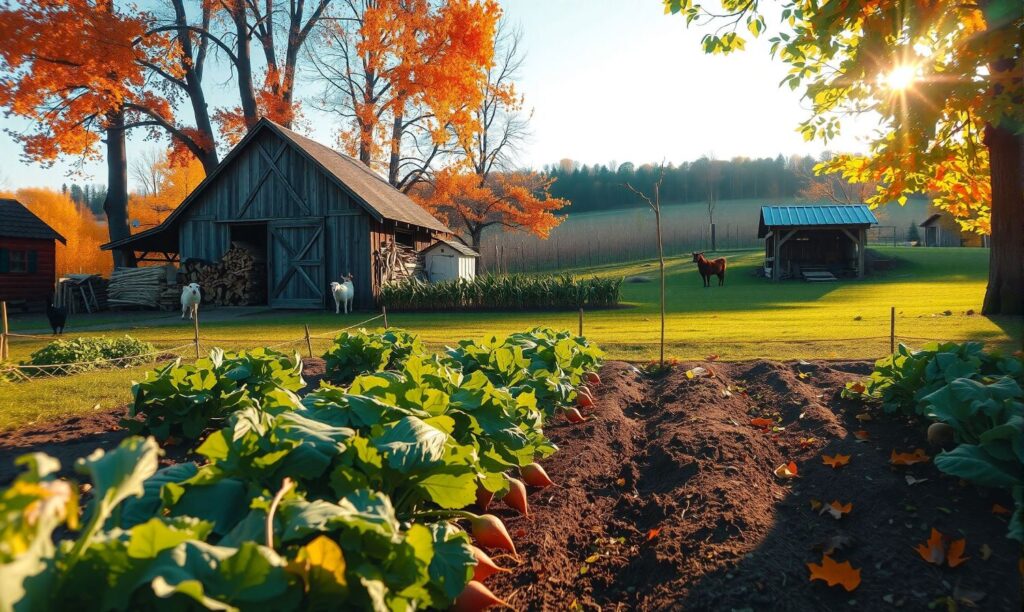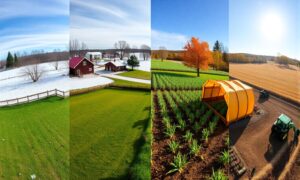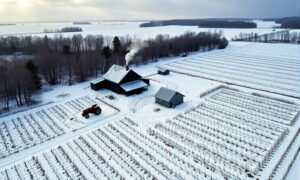
Fall is a critical season for homesteaders living on 5 acres. It marks the culmination of months of hard work and the beginning of essential preparations for the colder months ahead. Harvesting crops, preparing the land, and winterizing your property are all vital tasks that ensure the sustainability and productivity of your homestead year-round. In this comprehensive guide, we’ll explore the best practices for maximizing your fall harvest and preparing your 5-acre homestead for the coming winter.
Maximizing Your Fall Harvest on a 5-Acre Homestead
The fall harvest is one of the most rewarding times of the year for homesteaders. It’s when all your planting and tending finally pays off, but it’s also a time that requires careful planning and execution to ensure you make the most of your crops.
Harvesting Root Vegetables and Late-Season Crops
When it comes to managing a homestead on 5 acres, root vegetables like carrots, beets, and potatoes are some of the most reliable fall crops. These vegetables can be left in the ground longer than others, as they tolerate cooler temperatures well. However, timing is crucial. Harvest them before the first hard frost to prevent the ground from freezing and making them difficult to dig up.
Additionally, late-season crops such as pumpkins, winter squash, and Brussels sprouts should be harvested once they’ve fully matured. Pumpkins and squash, in particular, need to be harvested before frost to avoid damage. Allow them to cure in the sun for a week or two to toughen their skins, which helps them store longer through the winter.
Quick Tips for Harvesting:
- Harvest root vegetables before the ground freezes.
- Cure pumpkins and squash in sunlight to extend their storage life.
- Monitor late-season crops closely for signs of maturity.
Efficiently Preserve and Store Your Crops for Winter
After you’ve completed the harvest, the next step in preparing your 5-acre homestead for winter is preserving and storing your crops. Proper preservation ensures that you can enjoy the fruits of your labor throughout the colder months.
Canning and Freezing:
Canning is a popular method for preserving vegetables like tomatoes, beans, and peppers. When canning, make sure to follow safety guidelines to prevent foodborne illnesses. Freezing is another effective method, particularly for fruits and vegetables like berries, corn, and peas. Blanching vegetables before freezing them helps preserve their color, flavor, and nutritional value.
Storing Root Vegetables:
Root vegetables can be stored in a cool, dark place, such as a root cellar. If you don’t have a root cellar, an unheated basement or garage can work just as well. Keep these vegetables in sand or sawdust to maintain their moisture levels and prevent them from sprouting.
Quick Tips for Preservation:
- Follow safety guidelines for canning to avoid contamination.
- Blanch vegetables before freezing to maintain their quality.
- Store root vegetables in sand or sawdust in a cool, dark place.
Strengthening Soil Health for Next Season
An important aspect of fall preparation on a 5-acre homestead is taking care of your soil. After the harvest, planting cover crops is an excellent way to maintain and improve soil health. Cover crops, such as clover, rye, and vetch, help prevent soil erosion, suppress weeds, and add valuable nutrients back into the soil.
Benefits of Cover Crops:
Planting cover crops in the fall allows them to grow over the winter, providing ground cover that protects the soil from harsh weather. In the spring, these crops can be tilled into the soil to increase organic matter and improve soil structure. This practice, known as green manuring, enhances the fertility of your land, setting the stage for a successful growing season next year.
Soil Testing and Amendments:
Before planting cover crops, consider conducting a soil test to determine the nutrient levels in your soil. Based on the results, you can make targeted amendments, such as adding lime to balance pH or compost to boost organic matter. These steps will ensure that your soil is in prime condition for planting when spring arrives.
Quick Tips for Soil Health:
- Plant cover crops to protect and enrich your soil.
- Conduct a soil test before making amendments.
- Use green manuring to improve soil structure and fertility.
Preparing Your Homestead’s Infrastructure for Winter
As fall progresses, preparing your homestead for winter becomes increasingly important. This preparation involves more than just harvesting crops; it’s about ensuring your entire property is ready to withstand the challenges of the cold season.
Fall Maintenance for Outbuildings and Infrastructure
Maintaining your outbuildings and infrastructure is a key part of preparing your 5-acre homestead for winter. Start by inspecting your barn, shed, and any other structures for signs of wear and tear. Look for loose boards, leaks, or any damage that could worsen under winter conditions. Repairing these issues now can prevent more extensive damage later on.
Winterizing Equipment:
Winterizing your equipment is also crucial. Drain fuel from lawnmowers, tractors, and other machinery, and store them in a dry, sheltered place. If you use a wood stove or fireplace, ensure you have enough firewood stocked and that your chimney is clean and in good working order.
Quick Tips for Maintenance:
- Inspect and repair outbuildings before winter.
- Winterize all equipment to prevent damage.
- Stock up on firewood and ensure your chimney is clean.
Preparing Your Home for Cold Weather
Your home is your refuge during the winter months, so it’s essential to prepare it for the cold. Start by sealing any drafts around windows and doors to keep the heat in and the cold out. Adding insulation to your attic and walls can also help reduce energy costs and keep your home more comfortable.
Heating System Maintenance:
In addition to sealing and insulating, make sure your heating system is in good condition. Have your furnace or boiler serviced before the cold sets in, and change filters regularly to ensure it operates efficiently. For those relying on wood heat, now is the time to inspect and clean your chimney. A well-maintained chimney reduces the risk of chimney fires and ensures that your wood stove or fireplace operates safely.
Quick Tips for Home Prep:
- Seal drafts and add insulation to reduce energy costs.
- Service your heating system and replace filters regularly.
- Clean and inspect your chimney to ensure safety.
Winter Livestock Care Essentials
If you’re living on 5 acres with livestock, preparing for winter means ensuring your animals have adequate shelter and food. Start by inspecting and repairing barns, coops, and other animal housing. Ensure these structures are well-insulated and draft-free to keep your animals warm.
Feed and Bedding:
Stock up on feed and bedding materials, as access to these supplies may become limited during the winter. Consider adding extra layers of bedding, such as straw, to help insulate your animals from the cold ground.
Water Management:
Water is another critical factor. In freezing temperatures, water can quickly turn to ice, leaving your animals without a drinking source. Using heated waterers or adding water heaters to troughs can prevent freezing and ensure your livestock stays hydrated.
Quick Tips for Livestock Care:
- Ensure all animal shelters are insulated and draft-free.
- Stock up on feed and bedding materials before winter.
- Use heated waterers to keep water from freezing.
Effective Fall Pest Management
Fall is a time when many pests seek shelter from the cooling weather, and your garden and homestead can be prime targets. Taking steps to manage these pests will help protect your property through the winter.
Fall Pest Control on a 5-Acre Homestead
Rodents, insects, and other pests often try to enter homes and outbuildings as temperatures drop. Seal cracks and holes in foundations, walls, and roofs to prevent these pests from getting inside. Traps and natural repellents can also be effective for controlling populations around your homestead.
Natural Pest Repellents:
In addition to sealing your home, consider planting pest-repelling herbs like mint or rosemary around your property’s perimeter. These plants are known to deter common pests and can be harvested for use in your kitchen.
Garden Pest Management:
In the garden, clear away any plant debris that could harbor pests over the winter. Removing dead plants, weeds, and fallen fruit from your garden beds reduces the chances of pests surviving the cold season and returning in the spring.
Quick Tips for Pest Control:
- Seal cracks and holes in buildings to prevent pest entry.
- Use natural repellents like mint around your property.
- Clear plant debris from the garden to avoid pest infestation.
Garden Preparation: Setting Up for Spring Success
Properly preparing your garden for winter is a key part of living on 5 acres year-round. After clearing out plant debris, add a layer of compost or mulch to your garden beds. This helps protect the soil from erosion, maintains moisture levels, and adds nutrients that will benefit your crops in the spring.
Winter Protection for Perennials:
If you’ve planted perennials, such as berries or herbs, cut them back and add a thick layer of mulch around the base to protect their roots from freezing temperatures. For annual beds, consider using row covers or planting winter cover crops to keep the soil healthy.
Tool and Equipment Maintenance:
Finally, winterize your garden tools and equipment. Clean, sharpen, and oil tools to prevent rust and damage over the winter. Store them in a dry place where they’ll be ready to use when spring arrives.
Quick Tips for Garden Prep:
- Add compost or mulch to garden beds to protect the soil.
- Mulch around perennials to insulate their roots.
- Clean and store garden tools to extend their life.
Conclusion
Fall harvest and preparation are critical tasks for any homesteader living on 5 acres year-round. By following these best practices, you can ensure that your property remains productive, your animals stay healthy, and your home is ready to weather the winter months. From harvesting and preserving crops to winterizing your home and caring for livestock, the work you do in the fall sets the foundation for a successful and sustainable homestead all year long.
For more tips on managing your homestead throughout the year, check out our other articles on seasonal living.
FAQs
- When should I start harvesting my fall crops?
- Harvest fall crops before the first hard frost to avoid damage from freezing temperatures.
- How do I store root vegetables over the winter?
- Store root vegetables in a cool, dark place like a root cellar, and keep them in sand or sawdust to maintain moisture.
- What are the benefits of planting cover crops in the fall?
- Cover crops improve soil health, prevent erosion, and add nutrients, preparing the soil for spring planting.
- What should I look for when winterizing my outbuildings?
- Inspect for loose boards, leaks, and other damage that could worsen during winter, and make necessary repairs.
- How can I prevent pests from entering my home in the fall?
- Seal cracks and holes in foundations and walls, and use traps or natural repellents to manage pest populations.
- What is the best way to prepare my garden for winter?
- Clear plant debris, add compost or mulch, and consider planting cover crops to protect and enrich the soil.
- How can I keep my livestock’s water from freezing in the winter?
- Use heated waterers or add water heaters to troughs to prevent water from freezing.
- What should I do to prepare my home for winter?
- Seal drafts, add insulation, service your heating system, and ensure your chimney is clean and safe to use.
- How do I protect my perennials during the winter?
- Cut back perennials and add a thick layer of mulch around the base to insulate the roots from freezing temperatures.
- Why is fall preparation important for a 5-acre homestead?
- Fall preparation ensures that your homestead is ready to withstand winter challenges, protecting your crops, animals, and property.




